# XOR 문제 딥러닝으로 풀기
XOR
0,0 -> 0(-)
0,1 -> 1(+)
1,0 -> 1(+)
1,1 -> 0(-)
Neural Net
: XOR문제를 푸는 방법으로 제시

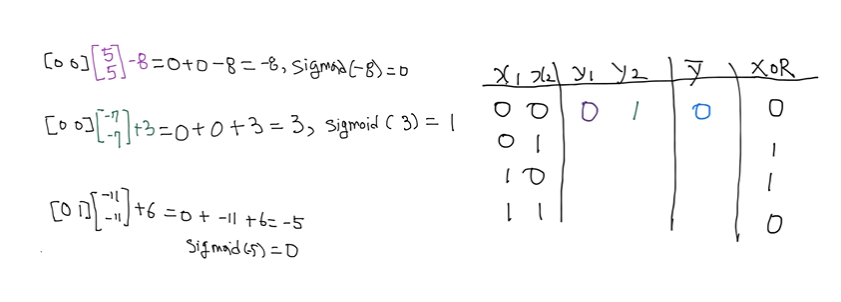


Forward propagation
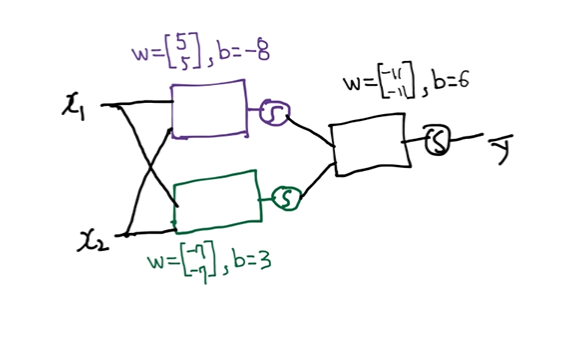
NN


network : programming code
K = tf.sigmoid(tf.matmul(X, W1) + b1)
hypothesis = tf.sigmoid(tf.matmul(K, W2) + b2)# 딥넷트웍 학습 시키기 (backpropagation)
How can we learn W1, W2, B1, B2 from training data?
: 기계적으로/ 자동적으로 어떻게 학습시킬 수 있을까?
: Gradient descent 알고리즘 사용 - 미분값 필요
: Neural Network에서 미분값이 복잡해짐 - 계산이 어려움
Backpropagation
: Gradient descent 알고리즘의 문제점을 해결해주는 알고리즘
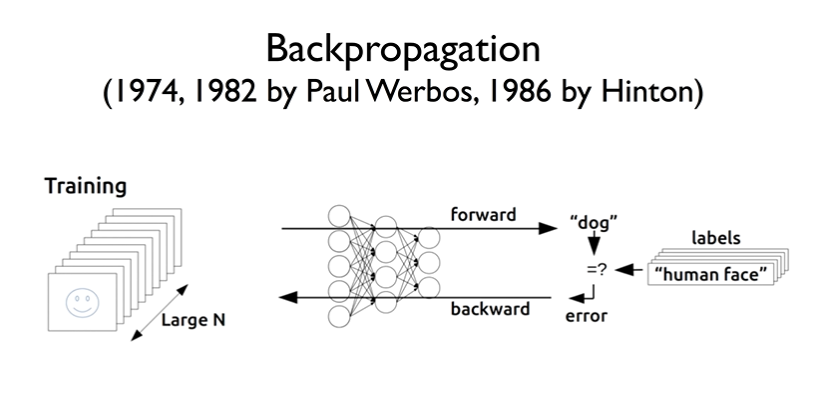
Back propagation (chain rule)
f = Wx + b
g = Wx
f = g + b
: W, x, b가 f에 미치는 영향을 구하고 싶음 = 미분 형태
1) forward (W = -2, x = 5, b = 3)
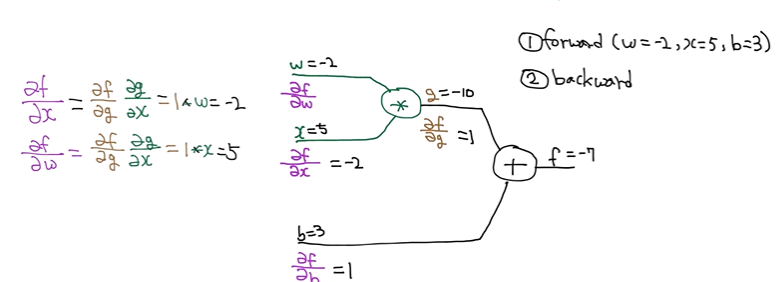
2) backward
: 좀 더 복잡해진 경우 - 마지막 노드부터 계산
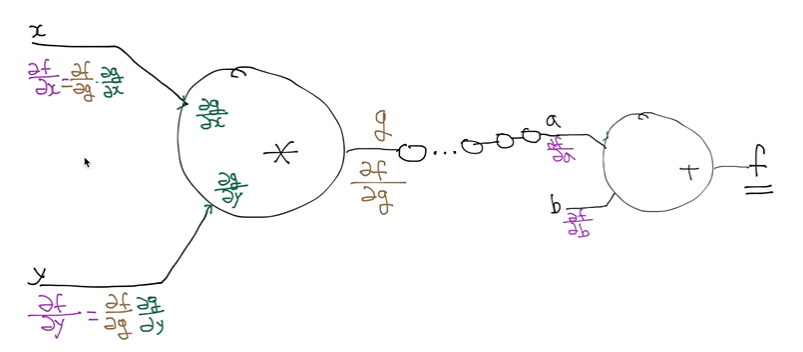
Tensorflow - TensorBoard
: backpropagation을 구하기 위해 그래프화 함
# Neural Nets XOR
Logistic Regression : XOR
: Logistic Regression으로 XOR문제를 해결할 수 없음
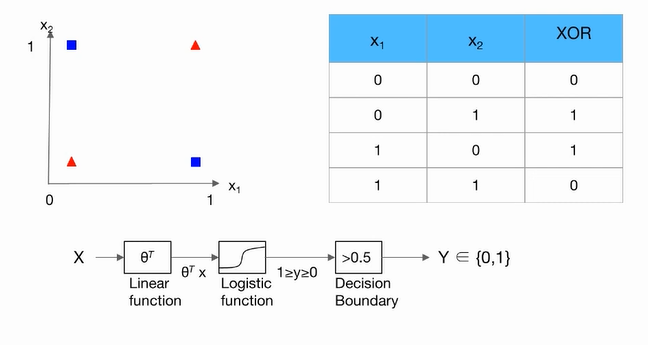
Data sets : Forward propagation
: 3개의 Logistic Regression으로 XOR문제를 해결할 수 있음.
: 위에 작성된 Forward propagtaion 참고
Neural Net : 2 layer

Tensorflow Code
def neural_net(features):
layer1 = tf.sigmoid(tf.matmul(features, W1) + b1) # W1=[2,1], b1=[1]
layer2 = tf.sigmoid(tf.matmul(features, W2) + b2) # W2=[2,1], b1=[1]
hypothesis = tf.sgimoid(tf.matmul(tf.concat([layer1, layer2], -1), W3) + b3) # W3=[2,1], b3=[1]
return hypothesisNeural Net : Vector
: 위에 작성된 NN 참고
: Logistic Regression 두 개를 더해서 하나의 component로 만들고 2 layer neural net을 만듬
Tensorflow Code
def neural_net(features):
layer = tf.sigmoid(tf.matmul(features, W1) + b1) # W1=[2,2], b1=[2]
hypothesis = tf.sigmoid(tf.matmul(layer, W2) + b2 # W2=[2,1], b2=[1]
return hypothesisNeural Net : Chart
: Logistic Regression을 합쳐 Neural Networks를 만들 수 있음
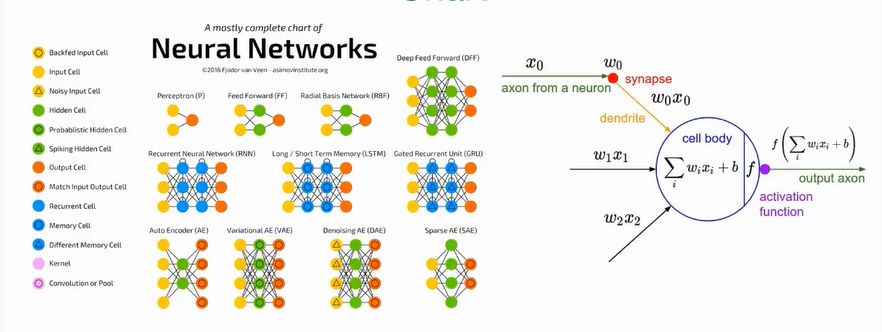
요약 Code (Eager)
import numpy as np
import matplotlib.pyplot as plt
%matplotlib inline
import tensorflow as tf
import tensorflow.contrib.eager as tfe
tf.enable_eager_execution()
tf.set_random_seed(777) # for reproducibility
print(tf.__version__)
x_data = [[0,0],
[0,1],
[1,0],
[1,1]]
y_data = [[0],
[1],
[1],
[0]]
dataset = tf.data.Dataset.from_tensor_slices((x_data, y_data)).batch(len(x_data))
def preprocess_data(features, labels):
features = tf.cast(features, tf.float32)
labels = tf.cast(labels, tf.float32)
return features, labels
W1 = tf.Variable(tf.random_normal([2, 1]), name='weight1')
b1 = tf.Variable(tf.random_normal([1]), name='bias1')
W2 = tf.Variable(tf.random_normal([2, 1]), name='weight2')
b2 = tf.Variable(tf.random_normal([1]), name='bias2')
W3 = tf.Variable(tf.random_normal([2, 1]), name='weight3')
b3 = tf.Variable(tf.random_normal([1]), name='bias3')
def neural_net(features):
layer1 = tf.sigmoid(tf.matmul(features, W1) + b1)
layer2 = tf.sigmoid(tf.matmul(features, W2) + b2)
layer3 = tf.concat([layer1, layer2], -1)
layer3 = tf.reshape(layer3, shape=[-1,2])
hypothesis = tf.sigmoid(tf.matmul(layer3, W3) + b3)
return hypothesis
def loss_fn(hypothesis, labels):
cost = -tf.reduce_mean(labels * tf.log(hypothesis) + (1 - labels) * tf.log(1 - hypothesis))
return cost
optimizer = tf.train.GradientDescentOptimizer(learning_rate=0.01)
def accuracy_fn(hypothesis, labels):
predicted = tf.cast(hypothesis > 0.5, dtype=tf.float32)
accuracy = tf.reduce_mean(tf.cast(tf.equal(predicted, labels), dtype=tf.float32))
return accuracy
def grad(features, labels):
with tf.GradientTape() as tape:
loss_value = loss_fn(neural_net(features),features,labels)
return tape.gradient(loss_value, [W1, W2, W3, b1, b2, b3])
EPOCHS = 50000
for step in range(EPOCHS):
for features, labels in tfe.Iterator(dataset):
features, labels = preprocess_data(features, labels)
grads = grad(neural_net(features), labels)
optimizer.apply_gradients(grads_and_vars=zip(grads,[W1, W2, W3, b1, b2, b3]))
if step % 5000 == 0:
print("Iter: {}, Loss: {:.4f}".format(step, loss_fn(neural_net(features),labels)))
x_data, y_data = preprocess_data(x_data, y_data)
test_acc = accuracy_fn(neural_net(x_data),y_data)
print("Testset Accuracy: {:.4f}".format(test_acc))
# TensorBoard XOR
Tensorboard for XOR NN
: Tensorboard를 사용하기 위해서는 아래 명령어를 실행시켜주어야 함
$ pip install tensorboard
$ tensorboard -logdir=./logs/xor_logs
Eager Execution
writer = tf.contrib.summary.FileWriter("./logs/xor_logs")
with tf.contrib.summary.record_summaries_every_n_global_steps(1):
tf.contrib.summary.scalar('loss', cost)Keras
tb_hist = tf.keras.callbacks.TensorBoard(log_dir="./logs/xor_logs", histogram_freq=0, wrtie_graph=True, write_images=True)
model.fit(x_data, y_data, epochs=5000, callbacks=[tb_hist])